Home → Water Quality → Monitoring and Reporting → Biomonitoring→ Sampling & Analysis → Algae
Algae
Algae are a complex and diverse group of mostly aquatic organisms that obtain their energy from sunlight through the process of photosynthesis. Algae can be found in macroscopic forms that are easily visible to the naked eye, as well as in microscopic forms that live free-floating in the water column and on rocks, wood, sand, and aquatic plants. Algae that float in the water column are called phytoplankton. Algae that live on rocks, logs, and sand are called periphyton. Algae that grow on aquatic plants and mosses are called epiphytes. The Biological Monitoring Program collects algal species from the following groups:
Cyanobacteria (formerly called Blue-Green Algae)
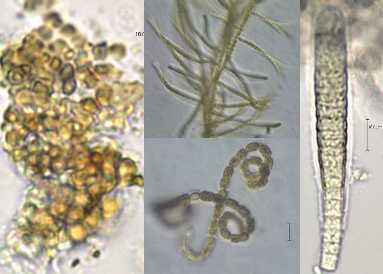 Cyanobacteria are primitive algae that are largely responsible for the Earth having an oxygenated atmosphere. Cyanobacteria are not plants and are more similar to bacteria. Unlike plants and animals, cyanobacteria do not have a cell nucleus. Cyanobacteria lack many of the advanced photosynthetic pigments found in other algae. Different species may appear blue-green (cyan) but may be other colors depending on which photosynthetic pigments they contain. Cyanobacteria can be unicellular, colonial, or form filaments and their cells are often much smaller than other algae. Some cyanobacteria are ecologically important because they convert atmospheric nitrogen into forms that can be used by organisms. Some cyanobacteria produce toxins that damage human liver and nervous systems.
Cyanobacteria are primitive algae that are largely responsible for the Earth having an oxygenated atmosphere. Cyanobacteria are not plants and are more similar to bacteria. Unlike plants and animals, cyanobacteria do not have a cell nucleus. Cyanobacteria lack many of the advanced photosynthetic pigments found in other algae. Different species may appear blue-green (cyan) but may be other colors depending on which photosynthetic pigments they contain. Cyanobacteria can be unicellular, colonial, or form filaments and their cells are often much smaller than other algae. Some cyanobacteria are ecologically important because they convert atmospheric nitrogen into forms that can be used by organisms. Some cyanobacteria produce toxins that damage human liver and nervous systems.
Red Algae (Rhodophyta)
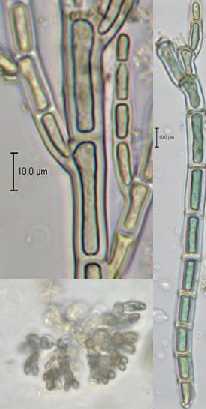 Red algae are thought to have evolved from a primitive, unicellular organism that engulfed and incorporated a cyanobacteria into its cellular structure. Red algae have a nucleus and their chloroplasts are bounded by two membranes thought to be the remnants of a food vacuole and a cyanobacterial cell. Chloroplasts of red algae retain some of the structure and pigments found in cyanobacteria. As their name implies, red algae are often red colored but are sometimes darkly colored. Different types of red algae may have unicellular, colonial, sheet, or filamentous forms. Some species have complex life cycles in which different phases might look completely different. There are few freshwater red algae in Maine . Most red algae live in salt water and some red seaweeds are commercially important for food (e.g., Porphyra), agar (e.g., Gracilaria), and carrageenan (e.g., Chondrus, Kappaphycus). Carageenan is used as a thickening agent for many foods.
Red algae are thought to have evolved from a primitive, unicellular organism that engulfed and incorporated a cyanobacteria into its cellular structure. Red algae have a nucleus and their chloroplasts are bounded by two membranes thought to be the remnants of a food vacuole and a cyanobacterial cell. Chloroplasts of red algae retain some of the structure and pigments found in cyanobacteria. As their name implies, red algae are often red colored but are sometimes darkly colored. Different types of red algae may have unicellular, colonial, sheet, or filamentous forms. Some species have complex life cycles in which different phases might look completely different. There are few freshwater red algae in Maine . Most red algae live in salt water and some red seaweeds are commercially important for food (e.g., Porphyra), agar (e.g., Gracilaria), and carrageenan (e.g., Chondrus, Kappaphycus). Carageenan is used as a thickening agent for many foods.
Green Algae (Chlorophyta)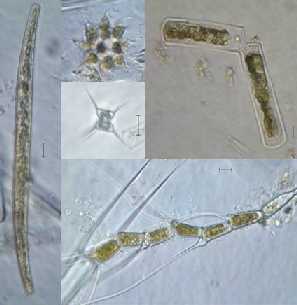
Similar to red algae, green algae are thought to have evolved from a primitive, unicellular organism that engulphed and incorporated a cyanobacteria into its cellular structure. They have a nucleus and and two membranes around their chloroplasts. Green algae are similar to plants because they share similar chloroplast structure, photosynthetic pigments, and metobolic storage products (e.g. starch). As their name implies, most green algae are green but there are exceptions. Different types of green algae may have unicellular, colonial, sheet, or filamentous forms. Some species have complex life cycles. Unlike red algae, there are many types of freshwater green algae in Maine.
Yellow-Green Algae (Tribophyceae)
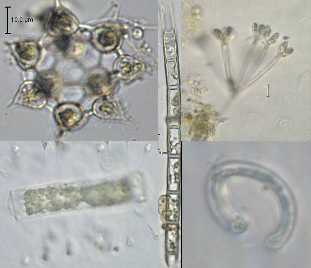 Yellow-green algae are a family of Brown Algae (Ochrophyta). They are thought to have evolved from a primitive, unicellular organism that engulphed and incorporated a red algae into its cellular structure. Each chloroplast is surrounded by four membranes that are thought to represent the original two membranes surrounding the red algae's chloroplast, the red algae's cell wall, and the membrane from the primitive organism's food vacuole. Brown algae chloroplasts contain chlorophylls a and c along with other photosynthetic pigments that give them a brownish color. Some yellow-green algae can be confused with green algae, however they do not produce starch. The starch in green algae turns a dark color when stained with iodine, but yellow-green algae do not produce starch and do not stain. Different types of yellow-green algae can have unicellular, filamentous, or siphonous forms. Vaucheria is a common yellow-green algae in Maine streams and is siphonous in form. A siphonous algae has long filaments that are hollow inside. Imagine a small straw inserted into a larger straw. All the cellular material is contained between the larger and smaller straws, while the area within the smaller straw is empty. A filament of Vaucheria has no cell walls. Technically, it is all one cell and the many nuclei, chloroplasts, and other cellular structures that flow throughout the filament.
Yellow-green algae are a family of Brown Algae (Ochrophyta). They are thought to have evolved from a primitive, unicellular organism that engulphed and incorporated a red algae into its cellular structure. Each chloroplast is surrounded by four membranes that are thought to represent the original two membranes surrounding the red algae's chloroplast, the red algae's cell wall, and the membrane from the primitive organism's food vacuole. Brown algae chloroplasts contain chlorophylls a and c along with other photosynthetic pigments that give them a brownish color. Some yellow-green algae can be confused with green algae, however they do not produce starch. The starch in green algae turns a dark color when stained with iodine, but yellow-green algae do not produce starch and do not stain. Different types of yellow-green algae can have unicellular, filamentous, or siphonous forms. Vaucheria is a common yellow-green algae in Maine streams and is siphonous in form. A siphonous algae has long filaments that are hollow inside. Imagine a small straw inserted into a larger straw. All the cellular material is contained between the larger and smaller straws, while the area within the smaller straw is empty. A filament of Vaucheria has no cell walls. Technically, it is all one cell and the many nuclei, chloroplasts, and other cellular structures that flow throughout the filament.
Diatoms (Bacillariophyceae)
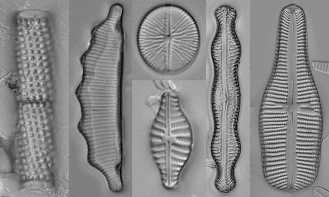 Diatoms are a family of Brown Algae (Ochrophyta) and share many characteristics with the yellow-green algae. The structure of diatoms is quite different, however. Diatoms have hard shells made of silica, which are formed by a top valve and a bottom valve that fit together. Diatom valves have many small holes in them that allow transfer of materials through the valves. Although they come in many shapes and sizes, diatoms are divided into centric forms (which are circular and radially symmetrical) and pennate forms (which are bilaterally symmetrical). Like many other algae, diatoms produce a gel-like substance called mucilage that helps them stick to surfaces and stick together to form colonies or filaments. Mucilage helps protect cells by keeping other things from growing on them. Some diatoms have slits in the valves, called raphes, which allow them to expel mucilage and move over surfaces. Some diatoms are tiny while others are huge in comparison. Diatoms are the most diverse group of algae in most Maine streams, rivers, and wetlands.
Diatoms are a family of Brown Algae (Ochrophyta) and share many characteristics with the yellow-green algae. The structure of diatoms is quite different, however. Diatoms have hard shells made of silica, which are formed by a top valve and a bottom valve that fit together. Diatom valves have many small holes in them that allow transfer of materials through the valves. Although they come in many shapes and sizes, diatoms are divided into centric forms (which are circular and radially symmetrical) and pennate forms (which are bilaterally symmetrical). Like many other algae, diatoms produce a gel-like substance called mucilage that helps them stick to surfaces and stick together to form colonies or filaments. Mucilage helps protect cells by keeping other things from growing on them. Some diatoms have slits in the valves, called raphes, which allow them to expel mucilage and move over surfaces. Some diatoms are tiny while others are huge in comparison. Diatoms are the most diverse group of algae in most Maine streams, rivers, and wetlands.
Euglenoids (Euglenophyta)
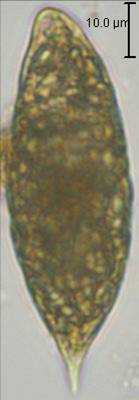 Euglenoids are more animal-like than other algae. They are thought to have evolved from unicellular organisms that engulphed and incorporated a green algae. Their chloroplasts have three membranes and have photosynthetic pigments similar to green algae. Some euglenoids photosynthesize and others have lost their chloroplasts completely and are predatory. Euglenoids have helical strips of semi-stiff material, called pellicles, inside their cell walls which give them a firm but flexible structure. They have a tail (flagella) for swimming and a red “eyespot” that is sensitive to light. Euglenoids cannot produce vitamins B1 or B12 on their own and are often restricted to nutrient enriched environments. Euglenoids, which are unicellular, are typically among the largest algal cells.
Euglenoids are more animal-like than other algae. They are thought to have evolved from unicellular organisms that engulphed and incorporated a green algae. Their chloroplasts have three membranes and have photosynthetic pigments similar to green algae. Some euglenoids photosynthesize and others have lost their chloroplasts completely and are predatory. Euglenoids have helical strips of semi-stiff material, called pellicles, inside their cell walls which give them a firm but flexible structure. They have a tail (flagella) for swimming and a red “eyespot” that is sensitive to light. Euglenoids cannot produce vitamins B1 or B12 on their own and are often restricted to nutrient enriched environments. Euglenoids, which are unicellular, are typically among the largest algal cells.
Dinoflagellates (Pyrrophyta)
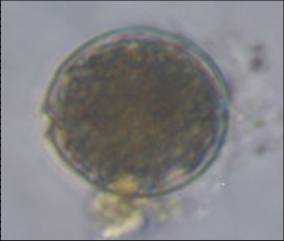
Most dinoflagellates are covered by plates of “armor” and have two flagella to help them swim. Dinoflagellates are more animal-like than other algae. About half of the dinoflagellates lack chloroplasts and are predatory. The other dinoflagellates are thought to have acquired chloroplasts by engulphing and incorporating a variety of other algae, including green algae, cryptomonads, diatoms, chrysophyceans, and haptophytes. Dinoflagellates, which are unicellular, are typically among the largest algal cells. Some dinoflagellates are thought to produce toxins.
Algae are an important component of the ecosystem in rivers, streams, and wetlands, making them a valuable indicator of water quality. Algae serve as a food source for invertebrates and small fish and play an essential role in nutrient and energy cycling. Algae strongly influence oxygen levels in the water column through photosynthesis and respiration. They are highly sensitive to a range of environmental stressors, including nutrient enrichment, changes in pH, and increased concentrations of some dissolved chemicals and contaminants. Some species of algae are more sensitive to changes in water quality than macroinvertebrates or fish. Since algae have rapid growth rates and respond quickly to changes in their habitat, they often provide an early warning of changing environmental conditions which may not be detected by other methods.
Algae can also tell biologists about the historical condition of waterbodies. A group of algae called diatoms creates cell walls that consist of silica, a glass-like material which persists in sediments over long periods of time. These cell walls can be collected from the sediment even after the organism inside them is gone, and can give scientists information about how an algae community has changed over time in response to changing pressure from environmental stressors.